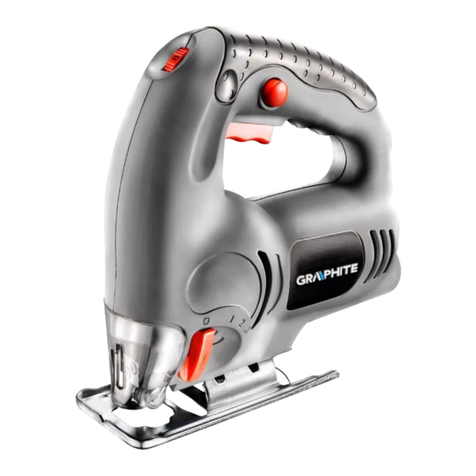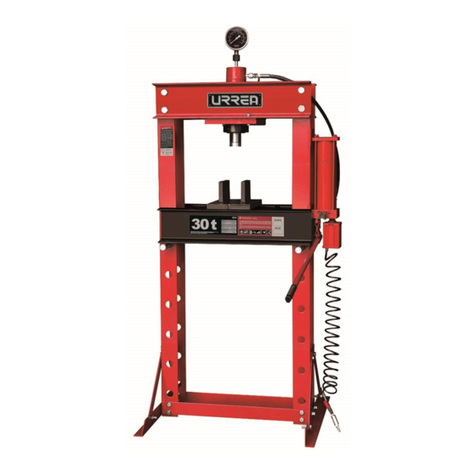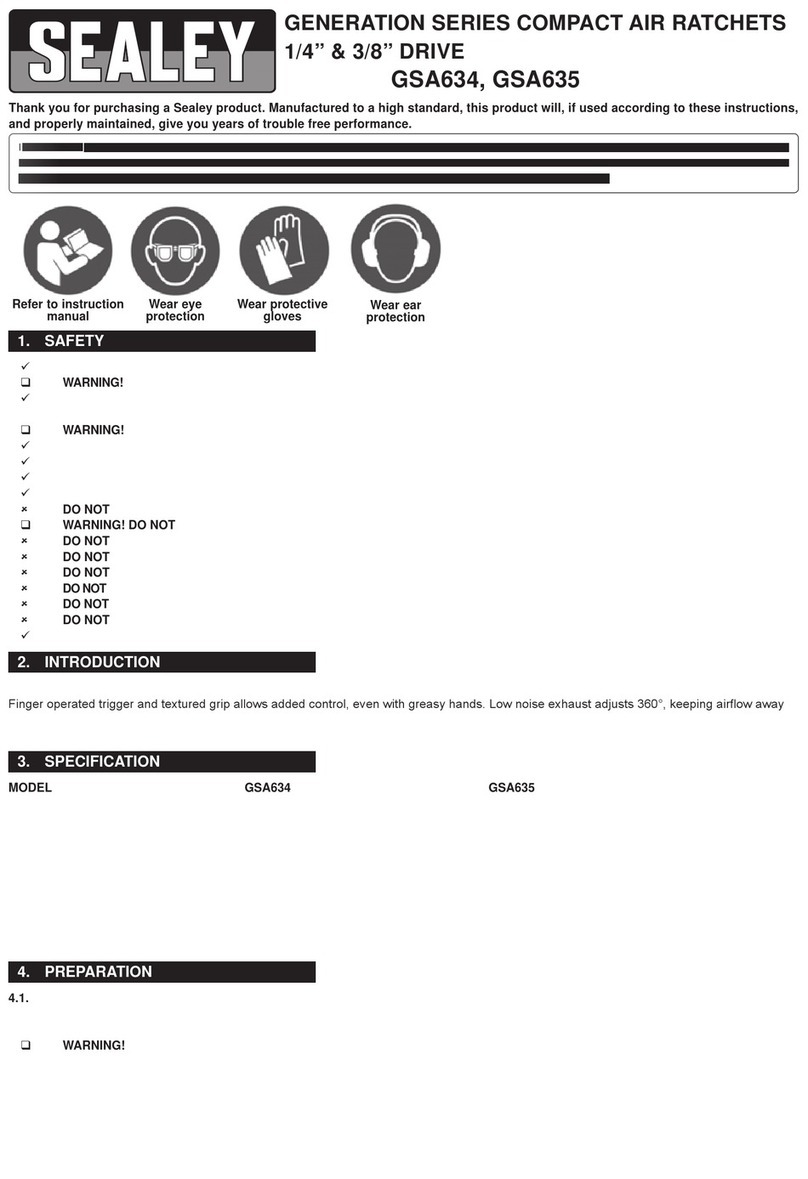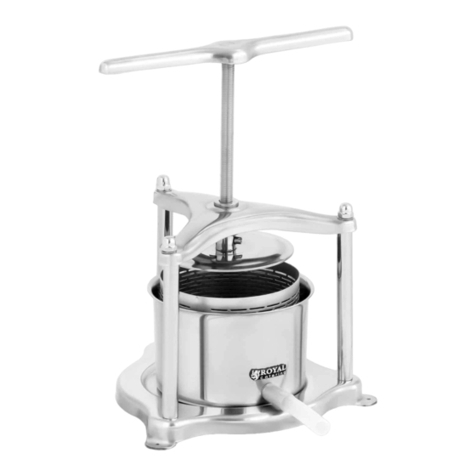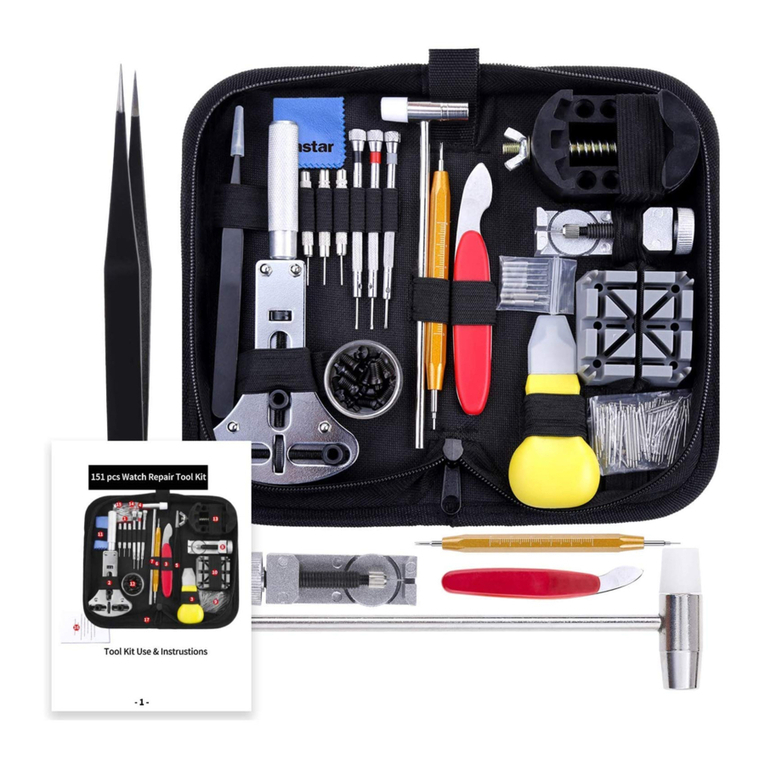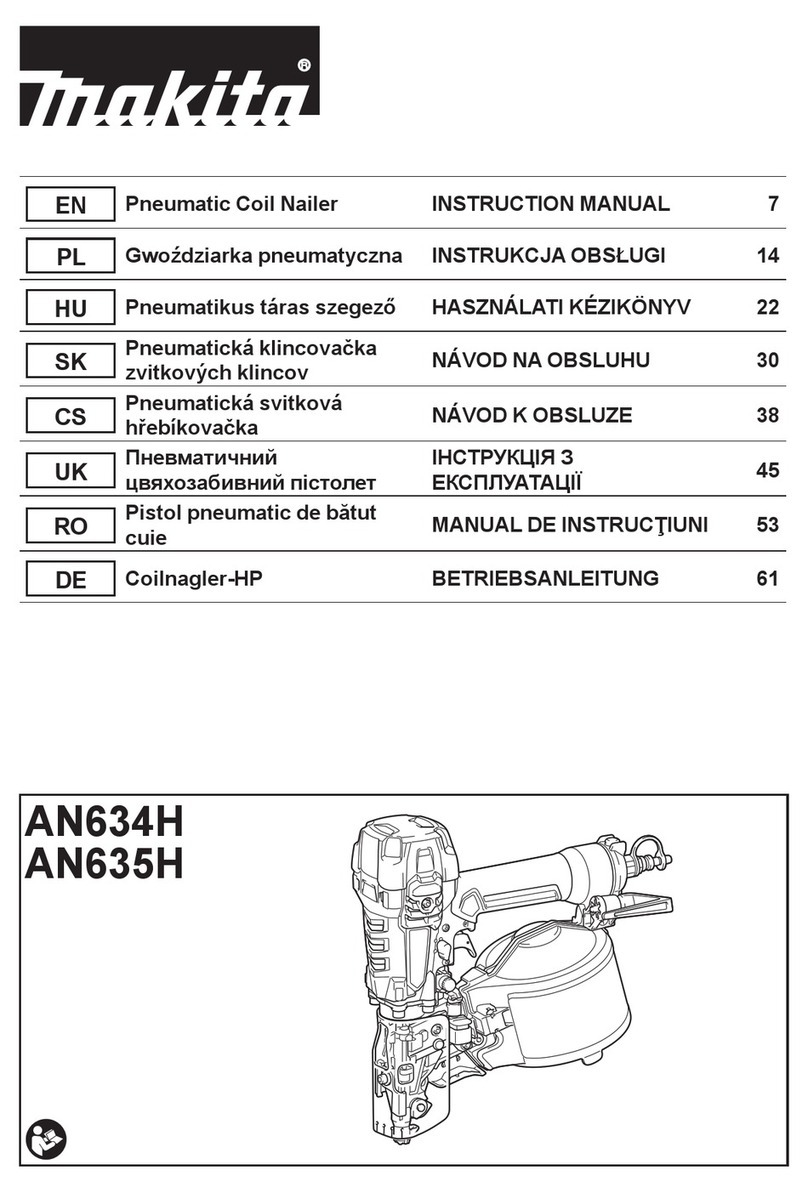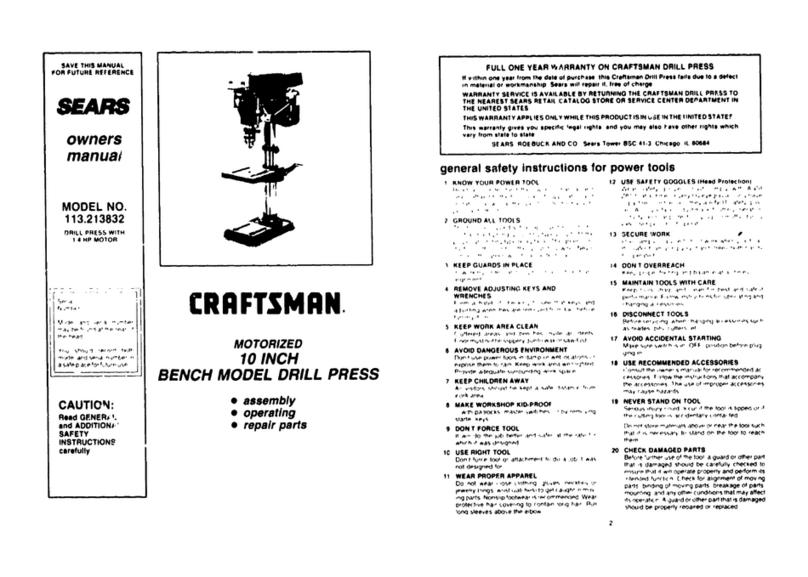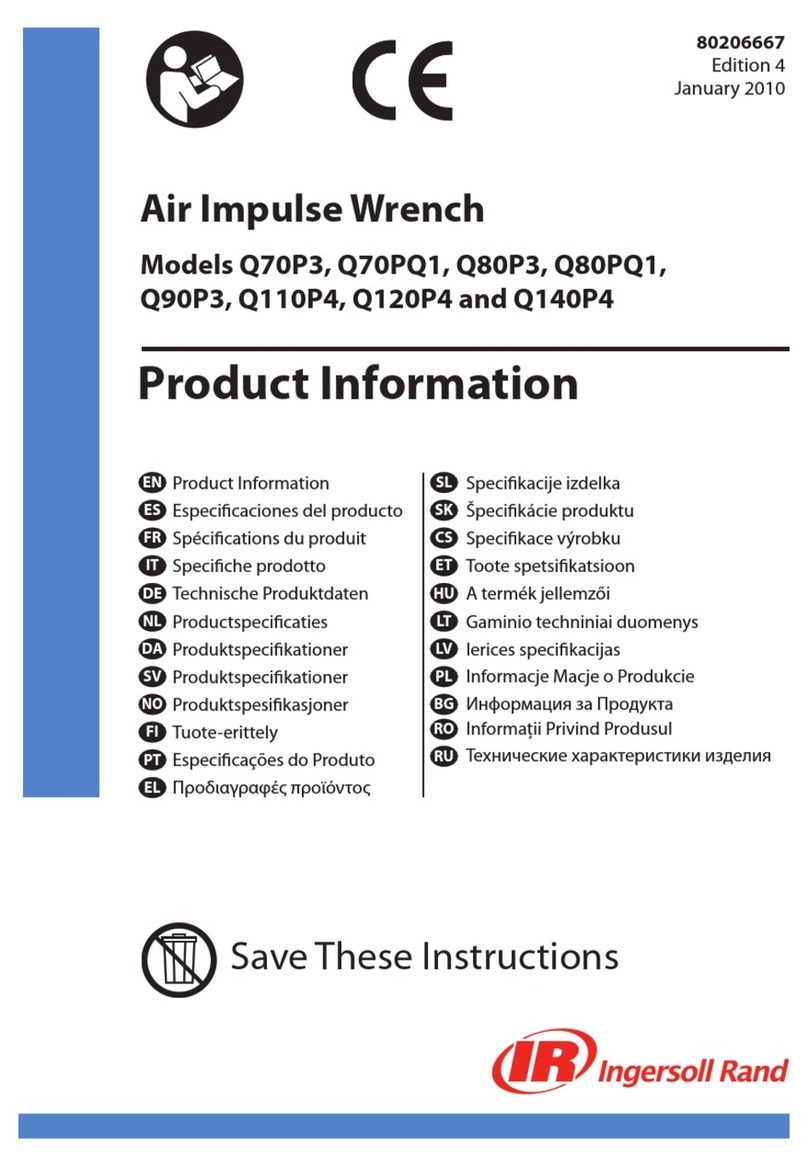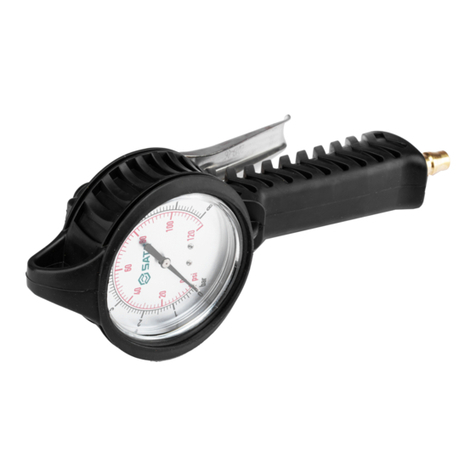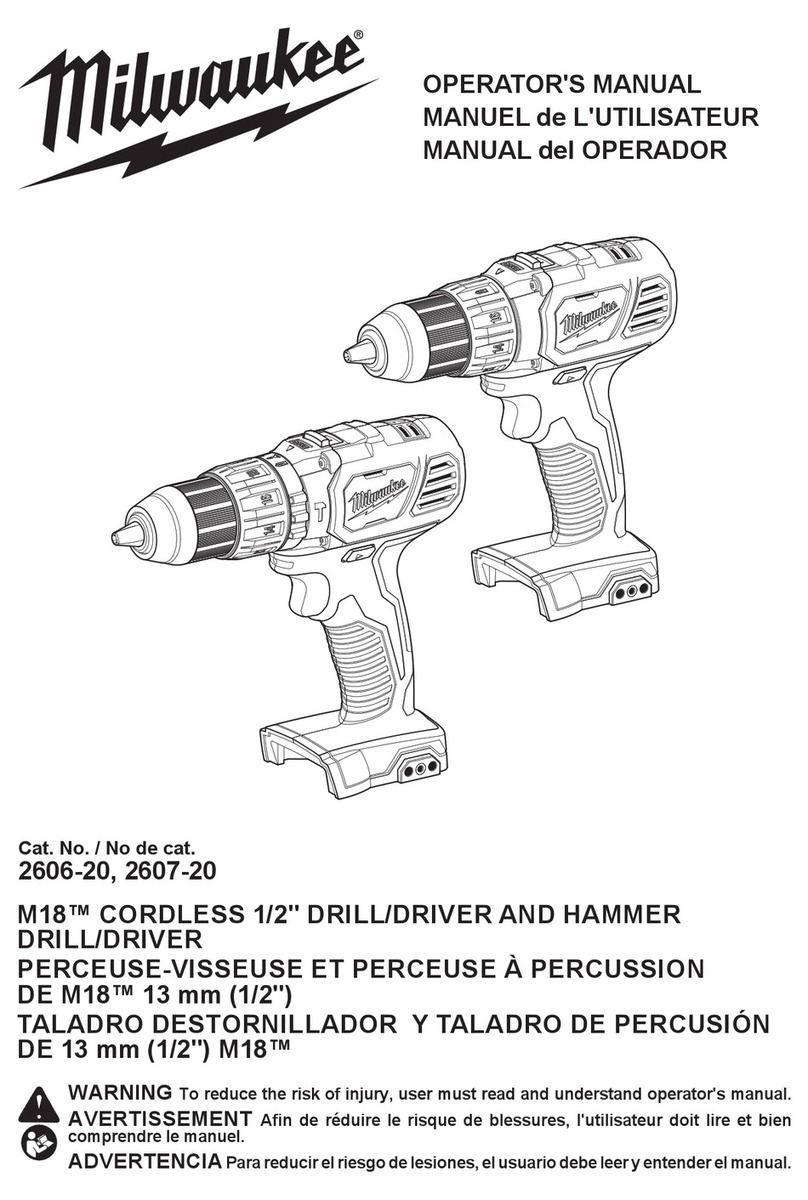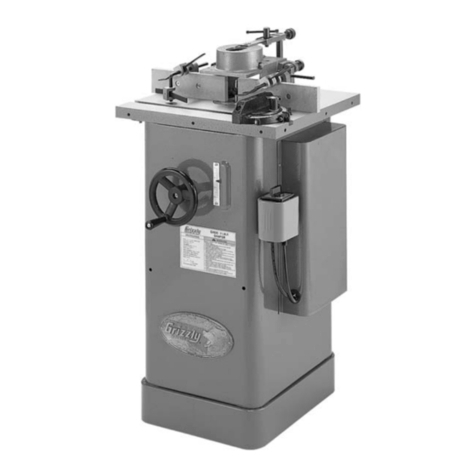Torc TTZ-1 Guide

TTZSERIES
OPERATIONAL
AND
SPARE PARTS
MANUAL
MAN-TTZ-2013

This manual applies to all tool part numbers in the TTZ Product Families. The complete
part number matrix which applies to this manual can be found in Appendix A and B
respectively. It is recommended the manual is kept up-to-date by checking the edition
and date code at the bottom of this page by utilizing the TORC, LLC. website and
downloading a copy of the most recent edition as needed.
TTZ PRODUCT FAMILY:
TTZ-1, TTZ-2, TTZ-4, TTZ-8, TTZ-14, TTZ-20
EN, EN-ISO, ISO Compliant
For a complete EC declaration of conformity or if
you require any further assistance please contact
your local TORC, LLC. representative or 1-888-444-
TORC (1-888-444-8672) or on the web at www.
TORC.com.
TORC, LLC.
124 Allegheny Road,
Mt. Bethel, PA 18343 USA
Tel: 888-444-TORC (8672)
Notice: The information contained in this document is subject to change without notice. TORC, LLC.
makes no warranty of any kind with regard to this material, including but not limited to, the implied
warranties of merchantability and fitness for a particular purpose. TORC, LLC. shall not be liable for
errors contained herein or for incidental or consequential damages in connection with the furnishing,
performance, or use of this material. It is further recommended that the end-user or repair
technician insure they have obtained and are familiar with the latest revision of the manual for the
equipment outlined in this document.
Restricted Rights Legend: Use and duplication of the information contained within this manual is
limited to the purchaser, end user, or licensed TORC, LLC. representative. It is recommended that proper
training for the equipment outlined in this manual be conducted by a TORC, LLC. authorized training
representative for any person who is operating or repairing the equipment outlined in this document.
Modification, or disclosure by any other agency or representative is strictly forbidden.
Product Modifications: TORC, LLC. DOES NOT ALLOW any of the products listed in this manual to be
modified by any end user without exception. Should an application require a modification to the tool, or
any of the standard accessories please consult with your local TORC, LLC. representative and they will be
able to obtain the assistance for any modification that may be required.
© Copyright TORC, LLC. 2013: All Rights Reserved. Reproduction, adaptation, or translation without
prior written permission is prohibited, except as allowed under the copyright laws.
1st Edition. Printed in USA. July 2013
Complies with standards publication BS EN 82079-1:2012

THANK YOU
FOR PURCHASING
THE VERY
FIRST
TORQUE/TENSION
SYSTEM AND THE VERY
FIRST
HANDS-OFF BOLTING
TOOLSIN THE
WORLD!!!
FREE
SAFETY TRAINING:
PLEASE READ
THE SAFETYINSTRUCTIONSHEREIN.
To ensure safe tool operation, please request a
FREE
Safety Training prior to use by calling
your
local TORC, LLC. Representative
1-888-444-8672
or
www.TORC.com.
We recommend one
Safety
Training every 6 months. These trainings are free of charge. Just call
us.
SYSTEM
INSPECTION:
Prior to any use, please inspect the entire tool system, including hoses,
gauge, sockets and backup wrenches. Do not use kinked hoses, oversized or heavily worn
sockets,
backup wrenches, damaged tools, pumps, connectors or gauges. Connect system to operate
from
a safe distance. Ensure fasteners are in good shape. Check tool function with drive or hex
ratchet
turning in one direction only and check out gauge from a safe distance that needle is on zero at no
pressure and at
10,000
psi at high pressure. Keep high pressure on and check system visually
for
leaks. Pleasekeep in mind that hydraulic tools are very strong and work at high pressure.
HANDS-OFF BOLTING:
The tool you have purchased permits hands-free operation from a safe
distance in conjunction with a Safety Washer. We recommend the use of a Safety Washer to avoid
finger-pinching, over-crowded sites
and to
ensure hands-off
bolting on all
verticaland
inverted applications, while eliminating improvising and the use of reaction members or backup
wrenches.
HANDS-FREE
WASHER
APPLICATION:
Make sure the drive and the tool are locked on securely.
FREE
ANNUAL TOOL
INSPECTION:
With the purchase of TORC, LLC., you have the right to a FREE
annual tool inspection, which includes free seals, springs and connectors and free lubrication. In
case
of
damaged
or worn
parts,
the first
inspection
within 13
months
of
purchase
is free of
charge
.
Thereafter, you will be informed of any cost prior to replacement. Any part replaced and
charged
by
us will be sent to you for your inspection upon request when P.O. is issued.
FREE LOANER
TOOLS:In case of tool failure during the warranty or rental period, please
contact
your local TORC, LLC. Agent for a free loaner tool -
24/7.
HOSE
REPLACEMENT:
We recommend replacing hydraulic hoses and oil every (3) three
months.
PLEASE
WEAR
REQUIRED
SAFETYATTIREand use common sense during
operation.
HELP:
If you require any further assistance, please call your local TORC, LLC. Representative or
1-888-444-TORC(1-888-444-8672),
on the web at
www.TORC.com
- 24/7! It’s live!
PLEASE REVIEW THESE
SAFETY
TIPS
BEFORE EVERY
TOOL USE
No. Safety
1-2-1009

4
CONTENTS
TTZSERIES
OPERATIONAL AND SPARE PARTS
MANUAL
INTRODUCING TORC, LLC.
5
SECTION I
IMPORTANT SAFETY INSTRUCTIONS
6
SECTION
II
INSTRUCTIONS BEFORE USE
8
2-1
W
ork
i
ng Pr
e
ssu
re
2-2 Hydraulic
C
onn
ec
tions
2-3
Elect
r
ica
l
C
onn
ec
tions
2-4 Air
C
onn
ect
ions
SECTION
III
OPERATION
10
3-1 Gen
e
r
a
l
3-2
C
onn
ec
ting the System
3-3 Inserting the Ratchet Link
3-5 Se
tti
ng Torque
3-5 Se
tti
ng Pressure
3-6 Applying Torque
3-7 Op
e
r
at
ing the
T
orque Ma
c
hine
3-8 Loosening Pro
ce
dures
SECTION
IV
TORC, LLC. POWER PACKS
15
4-1 General
4-2
Rem
ote
C
ontrol
4-3 Op
e
r
at
ion
SECTION
V
PREVENTIVE MAINTENANCE
17
5-1 Prev
e
n
t
ive Ma
i
n
te
n
a
n
c
e -
T
orque Ma
c
h
i
nes
5-2 Prev
e
n
t
ive Ma
i
n
te
n
a
n
c
e - Hydr
a
u
l
ic Power Packs
SECTION
VI
TROUBLESHOOTING
19
APPENDICES
23
A
TTZ
T
oo
l
Par
t
s
List
B
TT
Z
L
ow
Cle
a
r
a
nce
Li
nk Par
t
s
List
C
TT
Z
Slim
L
ink Par
t
s
List
D TTZ Dimensional Data

5
THANK YOU FOR
B
UY
I
N
G
TO
RC!
YOU ARE NOW HOLDING ONE OF THE WORLD'S LARGEST SELLING AND
MOST ADVANCED HYDRAULIC TORQUE/TENSION TOOLS.
TORC, LLC. is used more often, by more industries on more applications than all others combined.
If you maintain your new tool properly, it will last for years to come.
This manual is designed to provide you with the basic knowledge required to operate and maintain your TORC,
LLC. tool. Please read this manual carefully and follow the instructions provided. If you have any questions
regarding your TORC, LLC. tool, please call us directly at 888-444-8672 or fax 888-505-8672.
Finally, your purchase of this TORC, LLC. tool entitles you to the following FREE services:
•
Free on-site training in the application and operation of your TORC, LLC. equipment
•
Free semi-annual training
•
Free annual tool inspection
•
Free loaner tools in case of failure
•
Free engineering assistance by calling 1-888-444-TORC.
Your local TORC, LLC. office was informed of the delivery of this equipment. Should you require immediate
training, please feel free to call us directly to arrange an appointment with you at your convenience.
For additional information please visit our website at www.TORC.com
Again, thank you and welcome to TORC, LLC.!
Worldwide W
arranty
TORC, LLC. equipment is engineered to the latest technological standards and is backed by our exclusive
12-word, 13-month warranty.
"YOU BREAKIT UNDER NORMAL USE, WE FIX IT FREEOF CHARGE!"
If a TORC, LLC. Tool cannot be repaired on-site, FREE loaner TORC, LLC. equipment will be made available to
you upon request.
TORC, LLC. OR ITS DEALERS SHALL NOT BE LIABLE FOR LOSS OF PRODUCT OR OTHER INCIDENTAL OR CONSEQUENTIAL COSTS INCURRED BY THE BUYER OR THE USER.

6
SECTION
I
I
M
PORT
AN
T
S
AF
E
TY
I
N
STRU
CTI
O
N
S
WARNING: Your TORC, LLC.
TORQUE/TENSION
MACHINE is a power tool, and as with
any
power tool,
certain
safety
precautions
should be observed to avoid
accidents
or
personal
injury. The
following
tips will assist
you.
•
READ ALL INSTRUCTIONS
•
KEEP WORK AREA CLEAN AND WELL
LIT
•
CONSIDER WORK AREA ENVIRONMENT
Electrical Pumps should never be used in any atmosphere which can be considered potentially volatile.
If there is any doubt, use an air pump. Note: metal to metal contact can cause sparks,
precautions should
be taken.
•
AVOID PREMATURE TOOL STARTING
The Pump Remote Control is for the TOOL OPERATOR only. Avoid separate pump and tool operator.
•
STAY CLEAR DURING OPERATION
In most cases, the tool will allow “hands free” operation. If the tool must be held or steadied during
operation, use alternative means of securing the tool to the application.
•
GUARD AGAINST ELECTRIC SHOCK
Ensure the pump is properly grounded and the proper voltage is being used.
•
STORE IDLE TOOLS
When not in use, tools and accessories should be properly stored to avoid deterioration.
•
USE THE RIGHT TOOL
Don’t force small tools or attachments to do the job of a larger tool. Don’t use a tool for purposes not
intended. TORC, LLC. can develop custom accessories for your job to ensure safe and simple operation.
Contact your local TORC, LLC. representative for more information on our custom engineering abilities.
•
PROPER SAFETY
A
TTIRE
When handling/operating hydraulic equipment, use work gloves, hard hats, safety shoes, hearing
protection, and other applicable clothing.
•
USE SAFETY GLASSES
•
MOVING EQUIPMENT
Do not use hydraulic hoses, uni-swivels, pump power or remote cords as means of moving the equipment.

7
•
HOSES
Do not kink hoses. Inspect and replace if damaged.
•
SHROUDS AND COVER
PLA
TES
All tools are equipped with shrouds and/or cover plates to cover up moving internal parts. If shrouds are
missing or damaged, please contact your local TORC, LLC. representative for repair. A free loaner tool
will be made available to you during the time of repair.
•
MAINTAING TOOLS WITH CARE
For top performance, inspect tool powerpack, hoses, connectors, electric lines, and accessories for visual
damage frequently. Always follow instructions for proper tool and pump maintenance. Refer to the
Operations Maintenance Section for further clarification.
•
STAY ALER
T
Watch what you are doing. Use common sense. Do not use power equipment under the influence of any
mood altering substances.
•
PRIOR TO OPERATION
Ensure that all hydraulic connections are securely connected. Verify that the hydraulic hoses are not
kinked. Ensure the square drive and its retainer are fully and securely engaged.
•
PRIOR TO USE
Cycle tool to ensure proper function. Locate a solid, secure reaction point. Be sure the reaction arm retain-
ing clamp is fully engaged. Be sure the hydraulic hoses are free and clear of the reaction point. Pressurize
the system momentarily; if the tool tends to “ride up” or to “creep”, stop and re-adjust the reaction arm to a
more solid and secure position.
NOTE: For additional safety, a Reaction Washer can be used in place of the reaction arm; call your
TORC representative for more information.
•
ALWAYS USE QUALITY ACCESSORIES
Always use top quality impact sockets in good condition which are the correct size and fully engage the
nut. Hidden flaws, however, remain a possibility which could cause breakage, so stay clear of sockets
during operation.
•
DO NOT USE FORCE
Do not hammer on the socket or the tool to enhance performance. If the nut will not turn with the wrench
you are using, use a larger size TORC, LLC. tool.
•
REACTION
ARM
Proper reaction is required. Adjust reaction arm or plate accordingly. Avoid excessive play. In case of
questions, consult with your local TORC, LLC. office.

8
SECTION
II
I
N
STRU
CTI
O
N
S
B
E
F
O
RE
U
SE
READ CAREFULLY: Most
malfunctions
in new
equipment
are the result of
impr
oper
operation and/or
set-up
assembly
.
PREPARATION: Remove TORC Torque
Machine
from shipping
container
.
INSPECTION:
Visually inspect all
components
for shipping
damage.
If any damage
is
found, notify
carrier immediately
.
2-1
Working Pressure
The tool’s maximum working pressure is 10,000 PSI (700kg/cm2).
Make sure that all hydraulic equipment used with this tool is rated for 10,000 PSI Operating Pressure.
2-2
Hydraulic Connections
With older style pumps, the retract side of the system may remain pressurized after the pump has been switched
“off’. This trapped pressure makes it impossible to loosen the retract-side fittings by hand.
To release the pressure, find the 5/16” manual override holes in the end of the black solenoids on the pump. With a
welding rod, Allen key or similar device, push in on the ends of both solenoids, each in turn, and the residual
pressure will be released. All fittings will then be hand tight again.
Newer style pumps (HIGHFLOW, HIGHFLOW AIR or DYNAMIC) are equipped with an auto-pressure
relief.
Never disconnect or connect any hydraulic hoses or fittings without first unloading the wrench and the pump. If the
system includes a gauge, double check the gauge to ensure pressure has been released.
When making connections with quick disconnect couplings, make sure the couplings are fully engaged. Threaded
connections such as fittings, gauges, etc., must be clean, securely tightened, and leak free.
CAUTION: Loose or improper threaded fittings can be potentially dangerous if pressurized, yet, severe over
tightening can cause premature thread failure. Fittings need only to be securely tightened & leak free. Never
grab, touch or in any way come in contact with a hydraulic pressure leak. Escaping oil could penetrate the
skin and cause injury.

9
2-3
Electrical Connections
Ensure proper power availability to prevent motor failure or dangerous electrical overloading. Compare the
motor nameplate for required amperage.
Do not use electric pump if the 3-prong electrical plug is not whole.
Minimize the length of extension cords and be sure they are of adequate wire size, with ground connections.
Extension cord should be #10 AWG gauge.
WARNING: Electric motors may spark. Do not operate in an explosiveatmosphere or in the
presence of conductive liquids.Use an air motor pump Instead.
2-4
Air
Connections
Ensure that you have sufficient air flow (in cfm) to operate your pneumatic pump. If in doubt, compare the pump
manufacturer’s recommended air flow rating prior to pressurizing pump. Improper air flow may damage the pump
motor. For best results use air hoses larger than 3/4” I.D. diameter.
Use of a filter regulator lubricator (FRL) is highly recommended. (Pictured below.)
1. Adjust flow to one drop per 60 - 90 seconds
2. Fill half way with grade 46 hydraulicoil supplied

10
SECTION
III
O
PE
R
A
TI
O
N
3-1
General
All TORC, LLC. Torque Machines are supplied completely assembled and ready for use. A TORC Hydraulic
Power Pack (for use with your TORC machine) is recommended to provide the speed, pressure,
and
portability that makes your TORC System efficient and accurate.
The System accuracy of your TORC tool is +/- 3%, based upon manufacturer’s specifications. This
accuracy may be certified through calibration by TORC or any other qualifiedcalibration facility whose
program is traceable to the National Institute of Standards and Technology (N.I.S.T.).
Using a calibrated gauge enhances the accuracy of your TORC System.
3-2
Connecting
the
System
The wrench head and power pack are connected by a 10,000 PSI operating pressure (40,000 PSI burst)
twinline hose assembly. Each end of the hose will have one male and one female connector to assure proper
interconnection between pump and wrench heads.
IMPORTANT:
To avoid tool malfunction. Do not reverse connectors.
Connect the twinline hose to the uni-swivel as shown below:
Insure the connectors are fullyengaged and screwed
snugly
and completely together.

11
3-3
Inserting
the
Ratchet Link
The “hook” on the end of the power head is inserted into the cutout on the top of the link plates. The power head is
then swung down to rest along the base of the link side plate. At this point, the link pin hole of the power head and
link will align. Insert the link pin to secure.
Cutout
Hook
Link Pin
Torqueing Procedure
s
Link Pin
Select the appropriate size low clearance ratchet link and insert it into the tool.
The TTZ low clearance ratchet links are supplied complete with a long reaction block. This reaction block is
designed to react against an adjacent nut on most normal flange type applications. Before operating the tool, place
the tool with the low clearance link on the nut to be tightened/loosened. If the reaction block abuts against an
adjacent nut or to some other secure stationaryobject, then use of the reaction block is appropriate.
Reaction Block
If, however, bolt spacing is such that the reaction block does not reach
the
adjacent bolt, use of the short reaction arm is indicated. This will allow
reaction to be taken against the side of the flange. To attach the short
reaction arm, remove the standard link retaining pin, align with the holes
of the short reaction arm with those of the reaction block and insert the
long link retaining pin to secure. Insure that the arm extends in the
appropriate direction: right for tightening; left for loosening.
Reaction
Block

12
3-4
Setting
T
orque
Once the system is fully connected and the proper power supply is available, it is time to adjust the pump pressure
to the level needed on your job.
When tightening, use the manufacturer’s
specifications
to determine the torque value which you will ultimately
require.
Torque sequence may vary from plant to plant and even within individual plants, depending upon the gasket
material, etc. Always abide by local procedures.
The included torque chart is a guideline for comparison only and gives typical torque values specified for the most
commonly encountered fasteners.
Next, findthe pressure-torque conversion table applicable to the tool which you intend to use.
An example of finding the desired torque required is as follows: Assume you are going to use a TORC, LLC.
TTZ tool to torque a 1-1/4” bolt to 1,265 ft. lbs.
Start by going to the torque chart that was shipped with the tool. On the torque chart read left-to-right across the top
line to the column TTZ.
Start by referring to the pressure-torque conversion table for the tool you are using and read left-to-right across the
top line to the rightmost column.
Now using 1,280 ft. lbs., read back to the left on that same line and read the pump pressure, under the PSI column,
4,000PSI.
To be technically correct, you should diminish that 4,000PSI by 1.5% ( to 3,940), but 1,280 is well within the tool’s
+/-3% accuracy range, so proceed to set 4,000PSI on your pump’s regulator valve.

13
3-5
Setting
the
Pressure
on the
Pump
To set the pressure on the pump, follow this procedure:
1. Loosen the wing nut below the “T” handle on the pump’s external pressure regulator. Then turn the
“T” handle (shown below) counterclockwise (CCW) until it turns freely and easily.
2. Turn the pump “on”. Using the pump’s remote control pendant, push down the advance switch (or button on air
pumps) and hold it.
3. While holding the pump in the advance mode, slowly turn the “T” handle clockwise and observe the pump
pressure gauge rise.
NOTE: Always adjust the regulator pressure up - never down.
4. When your gauge reaches 4,000 PSI, stop turning the “T” handle and let the gauge settle out.
5. If the pressure continues to rise (above 4,000), release the advance button and back off your pressure slightly by
turning CCW on the “T” handle. Then re-depress the advance switch on your remote and slowly bring pressure
up to 4,000 again.
6. When the pressure is correct, turn the pump “off’ and tighten the wing nut provided under the “T” handle.
This sets pump pressure, which determines torque tool output.
7. Once your target pressure is set and locked, cycle the pump once more to ensure that your pressure setting did not
change as you turned down the wing nut.
3-6
Applying
the
Torque Machine
- the
Tightening Process
1. Having set your target pressure, cycle the tool three or four times to full pressure before putting it on the
application. Cycling the tool ensures that the system is operating properly and removes trapped air, if any.
2. Place the proper size impact socket on the square drive and secure properlywith a locking ring and pin.
3. Place the tool and the socket on the nut, making sure that the socket has fully engaged the nut. Further ensure that
the drive retainer is engaged.
4. Make sure the reaction arm is firmlyabutted against a stationary object (e.g. an adjacent nut, flange, equipment
housing etc.)
5. When positioning the wrench, make sure that the hose connections are well clear of any obstructions, and that all
body parts are safely out of harm’s way.
6. THEN, AND ONLY THEN, apply momentary pressure to the system to ensure proper tool placement. If it
doesn’t look or act right, stop and re-adjust the reaction arm.

14
3-7
Operating
the
Torque Machine
1. By pushing down on the remote control button in the advance position, the rear of the tool will be pushed back
until the reaction arm makes contact with its reaction point.
2. Continue to hold down the button as the socket turns until you hear an audible “click” which will signify the
hydraulic cylinder inside the tool is fully extended and will not turn the socket further.
3. Continuing to hold down the remote control button will result in a rapid buildup of pressure to the point of where
the gauge reads what was preset prior to applying the wrench.
IMPORTANT:
The reading of full preset pressure after the cylinder is extended DOES NOT
INDICA
TE
that this pressure (torque) is applied to the bolt. It onlyindicates that the cylinderis fully
extended and cannot turn the socket further until the tool automatically resets itself.
Releasing the remote control button will retract the cylinder. The tool will automaticallyreset itself and the operator
will hear an audible “click” indicating he can again push the remote control button and the socket will turn.
Each
time
the cylinder is extended and retracted, it is called a cycle. Successive cycles are made until the tool “stalls”
at
the
pre-set Torque/PSI with an accuracy of ±3% and ±1%. Repeatability is +1 -1%.
IMPORTANT: ALWAYS
ATTEMPT ONE FINAL CYCLE TO INSURE THE
“STALL”
POINT HAS BEEN
REACHED.
3-8
Loosening Procedures
First, set the pump to 10,000 PSI. Change the drive and the reaction arm to the loosening mode, assuring the
reaction arm abuts squarelyoff a solid reaction point. Press and hold the remote control button down. Pressure will
decrease as the socket begins to turn. As the cylinder extends fully, you will hear an audible “click”. Release the
remote control button, and the cylinder automatically retracts, at which time you again hear the audible “click”.
Repeat this process until the fastener can be removed by hand.
NOTE: IF THE BOLT DOES NOT LOOSEN WITH THE
ABOVE
PROCEDURE, IT IS AN INDICATION
THAT YOU REQUIRE THE NEXT
LARGER
SIZE TOOL TO LOOSEN THE BOLT.

15
SECTION
IV
TORC POWER
P
ACK
S
4-1
General
Information
All TORC Power Packs operate in a pressure range from 500 to 10,000 PSI and are fully adjustable. They
have been engineered and designed for portability and high flow for increased speed. Before using your TORC
power pack, check the following points:
•
Is the reservoir filled with oil?
•
Where is the closest electrical outlet at the job site?
•
Is there enough air pressure (100 PSI) and flow at the job site? (Airunits only)
•
Is the gauge mounted and rated for 10,000 PSI?
•
Is the oil filler plug securely in place?
4-2
Working Pressure
The Pump’s maximum working pressure is 10,000 PSI(700 kg/cm2). Make sure all hydraulic equipment and
accessories are rated for 10,000 PSI operating pressure.
4-3
Hydraulic Connections
Never disconnect or connect hydraulic hoses or fittingswithout first unloading the wrench. Unplug the electrical
cord of the pump, and open all hydraulic controls several times to ensure that the system has been depressurized. If
the system includes a gauge, double check the gauge to ensure pressure has been released.
When making a connection with quick disconnect couplings, make sure the couplings are fully engaged.
Threaded connections such as fittings, gauges etc. must be clean, securely tightened, and leak free.
CAUTION: Loose or improperlythreaded couplers can be potentially dangerous if pressurized.
However, severe over tightening can cause premature thread failure. Fittings need to be only
tightened secure and leak free. Never grab, touch, or in anyway come in contact with a hydraulic
pressure leak. Escaping oil could penetrate the skin and cause injury.
Do not subject the hose to potential hazards such as sharp surfaces, extreme heat or heavy
objects. Do not allow the hose to kink and twist. Inspect the hose for wear before it is used.

16
4-4
Electrical Power
1. CHECK FOR PROPER ELETRICAL SUPPLY BEFORE CONNECTING.
2. THIS MOTOR MAY SPARK. DO NOT OPERATE IN AN EXPLOSIVE ATMOSPHERE OR IN PRESENCE
OF CONDUCTIVE LIQUIDS.
a. Do not use a power or extension cord that is damaged or has exposed wiring.
b. All single phase motors come equipped with a three prong grounding type plug to fit the proper
grounded type electrical outlet. Do not use a two prong ungrounded extension cord as the pump’s
motor must be grounded.
3. COMPARE MOTOR NAMEPLATE AGAINST POWER AVAILABILITY TO PREVENT MOTOR BURN
OUT OR DANGEROUS ELECTRICAL OVERLOADING.
4-5
Prior to
Use
Check hydraulic oil level to prevent possible pump burnout. Open the filler plug located on the reservoir plate. Look
at oil fill level on the oil sight gauge. The oil level should be approximately 2” from the top of the reservoir plate-
with motor off. Add TORC, LLC. oil as necessary. Do not mix different grades of oil.
Make sure all desired gauge, valve, hose and quick coupler connections are tight and secure before operating.
The use of a pressure gauge is required for normal pump operation. Mounted on the manifold, the gauge permits the
operator to monitor the load on the wrench. 114% calibrated gauges are available for most applications.
4-6
Operation
Before starting your Electric Pump, connect your hydraulic hoses to both the pump and torque wrench.
Place the toggle switch in the ON position and the rocker switch on the hand control pendant in the OFF position.
To start the pump, depress and release the safety button.
NOTE:The safety button is an added feature designed to prevent premature starting and should
onlybe depressed by the tool operator.
Push the rocker switch to advance and release. This will start your pump and place it in the retract position.
NOTE:Read the section labeled TORC OPERATIONS and SETTING TORQUE prior to
installing
the torque wrench onto the application.
Your TORC hydraulic pump has been designed with an auto shut off system. The pump will shut off after
approximately30 seconds of non-cycling. This will prevent overheating and unnecessarywear which will prolong
the life of your pump. To restart the pump, the yellow safety button must again be depressed prior to use.

17
SECTION
VI
PRE
VE
N
TI
VE
M
AI
N
TE
N
AN
CE
5-1
Preventive Maintenance
-
Torque Machines
Tool failure, although rare, does occur. Such failure is most often in the hydraulic couplers or hoses. These items are
repairable or replaceable immediately. Failure of structural members of the tool are quite rare, but replacement parts
are available from stock. All repairs to TORC, LLC. tools may be made by reasonably experienced individuals
according to the aforementioned instructions.
•
Lubrication
All moving parts should periodically be coated with a good quality NLGI #2 molybdenum disulfide grease. Under
harsh environmentalconditions, cleaning and lubricating should be performed more frequently.
•
HydraulicHoses
Hoses should be checked for cracks and leaks after each job. Hydraulic fittings can become plugged with dirt and
should be flushed periodically.
•
Quick-Connects
Fittings should be kept clean and not allowed to be dragged along the ground or floor, as even small particles of dirt
can cause the internal valves to malfunction.
•
Springs
Springs are used for the drive pawl assembly and for the accuracy assurance pawl. These springs can be replaced if
necessary.
•
Cylinder Seals
If the cylinder requires disassembly, it is recommended that the cylinder seals be replaced at the same time. Seal kits
are readily available.
•
StructuralMembers
All structural parts on the tool should be inspected once a year to determine if there are any cracks, chips or
deformities. If so, immediate replacement is required.

18
5-2
Preventive Maintenance
-
Hydraulic
Power
Packs
TORC, LLC. Hydraulic Power Packs are precision-built units and, as such, do require a certain amount of care and
maintenance.
• HydraulicOil
Oil should be completely changed after every 40 hours of operation, or at least twice a year. Always make sure the
reservoir is filled with fluid. If additional oil is required, use only high-grade hydraulic oil.
• Quick-Disconnects
Fittings should be checked periodically for leaks. Dirt or foreign materials should be kept away from fittings. Clean
before use.
•
Hydraulic Gauge
Some gauges are liquid filled. Should this liquid level drop, it indicates external leakage, and replacement is
necessary. Should the gauge fill with hydraulic oil, it indicates internal failure and it should be discarded.
• Filter
on
Pump
The filter should be replaced twice a year in normal use and more often if the pump is used daily or in a dirty, harsh
environment.
• RemoteControl
(Air Unit) The airline to the remote control unit should be checked for obstructions or kinks in the line periodically.
If there is a bend or break in the line, it must be replaced. The spring-loaded buttons on the remote handle should be
checked in the event of operating difficulties. (Electric Unit) The rocker switch should be checked periodically if
any indication of problems exist.
•
Air
V
alve
This valve should be checked twice a year.
• Brushes
and
Brush Holders
(Electric Unit) Check and replace, if worn.
•
Armatur
e
(Electric Unit) Check yearly.

19
SECTION
VI
TRO
UB
L
E
S
HO
O
TI
N
G
SYMPTOM
PROBABLE
CAUSE
REQUIRED ACTION
Gauge shows pressure build-up but the
tool will not cycle
1. Couplings loose or inoperative
2. Solenoid inoperative
1. Tighten and/or replace couplings. Use Test #1
listed below to isolate problem.
2. Check using test #2 below. If solenoid is bad,
replace.
Cylinder will not retract.
1. See above
2. Voltage to electric pump is too low
to line drop or inadequate amperage is
available.
3. Linkage between piston rod and drive
arms are broken.
1. See Above
2. Get shorter extension cord or upgrade to
12AWG, 25 amp rating or better. If shop power is
adequate, draw power from welding machine or cal
rod transformer.
3. Replace parts as necessary.
Cylinder pressure will not build.
1. Oil blow by in tool (Piston seal leak,
blown O-ring, cracked piston)
2. Pump Problem
1. Replace defective parts. SHOP JOB
2. Check to see if sub-plate is worn by; a) Remove
screws from pump motor to reservoir, slide Pump
motor to the side, turn pump on and while holding
down on the button, put your finger on the dump
tube (round tube under the directional control
valve) - if you feel pressure, then replace the sub-
plate and shear seals.
2A. Check to see if you have leaks from the
external relief valve and the 2 oil line connections
(bottom of relief valve and connection into pump
body’s other end) of oil line. If leaking, retighten
with 9/16” open end wrench. SHOP JOB
2B. If pump sounds like a lot of pebbles in a tin
can, the problem may be a worn motor coupling.
Remove motor from base plate - using a pair of
needle nose pliers remove the motor coupling - if
worn, replace. SHOP JOB
2C. AIR PUMPS - Faulty Air Valve due to exces-
sive moisture and/or dirt in air supply. Disassemble
air valve and wipe any residue from air
valve piston.
Spray brake cleaner into air valve body,
dry thoroughly. Disassemble all small air lines and
blow out with compressed air. Lubricate both air
valve piston and body with hydraulic oil (sparingly)
and reassemble. SHOP JOB
2D. Air pumps - Faulty remote control valve
cartridge. Replace.

20
SYMPTOM
PROBABLE
CAUSE
REQUIRED ACTION
Cylinder/Tool leaks
1. Safety relief valve on swivel has lifted.
2. Blown O-ring in cylinder
3. Defective gland seal.
1A. Tighten all hose and couplers. If leak contin-
ues, adjust safety setting - Test #4
1B. Check to see if the system is properly plumbed
by running test #5 (high pressure on retract
side
will
lift the safety relief valve)
2. Replace O-Ring with proper high pressure O-
Ring. SHOP JOB
3. Replace gland seal. SHOP JOB
Tool operates backwards
1. Couplings reversed
2. Multiplehoses in even numbers
1. Run test #5. Replum system as necessary.
2. As plumbed, TORC, LLC. hoses may only be
joined together in odd numbers ONLY. If it is
necessary to use 2,4,6 hoses - make an adapter from
spare high pressure couplings and nipples.
Ratchet returns with retract stroke
1. Broken or otherwise inoperable drive
segment.
1. Replace drive segment and/or spring. SHOP
JOB.
Ratchet will not take successive strokes
1. Broken or otherwise inoperative drive
segment I or spring
2. Cylinder not retracting completely
3. Linkage between piston rod and drive
plates is broken
1. Replace drive segment and/or spring. SHOP JOB
2. Remove tool from nut and cycle freely for sev-
eral strokes. If problem persists, check pawls.
2A. Operator not allowing adequate time for cylin-
der to retract fully.
3. Replace parts as necessary - SHOP JOB.
Tool locks onto nut
1. Drive segment is loaded when the tool is
max’d out in torque
2. Tool is operating backwards
3. Tool is wedged under a fixed object
1. Press advance button on remote and build pres-
sure - continue to press down on remote while
pulling back on one of the accuracyassurance
levers - release remote while continuing to hold
back on levers
2. Push advance button down - tool should immedi-
ately fall free- Run test #5
3. Remove shroud from around ratchet. Using any
tool available, pry the drive segment out of the
ratchet and at the same time pull back on the
accuracyassurance levers. Tool should swing free
or burn away the socket or obstruction.
This manual suits for next models
5
Table of contents
Popular Power Tools manuals by other brands
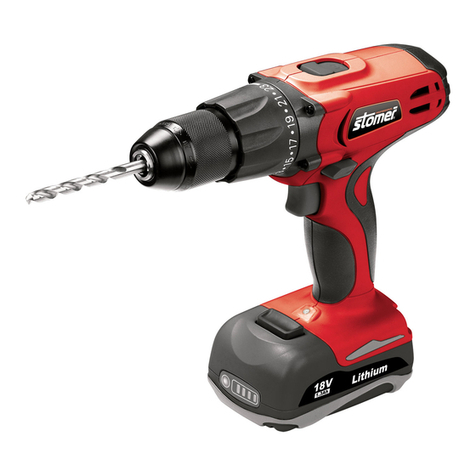
Stomer Professional
Stomer Professional SAD-18x2LiD-XL user manual
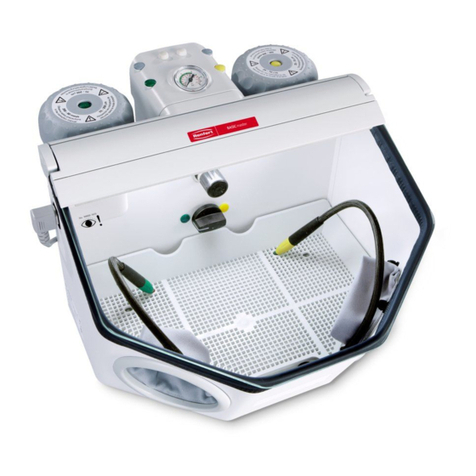
Renfert
Renfert Basic Master instruction manual

TOOLCRAFT
TOOLCRAFT 1662864 operating instructions

Porter-Cable
Porter-Cable PC1500HG instruction manual
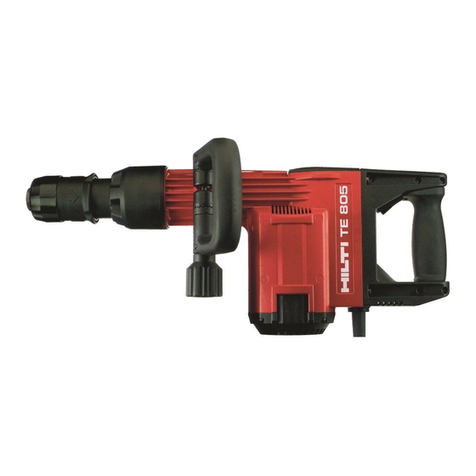
Hilti
Hilti TE 805 operating instructions
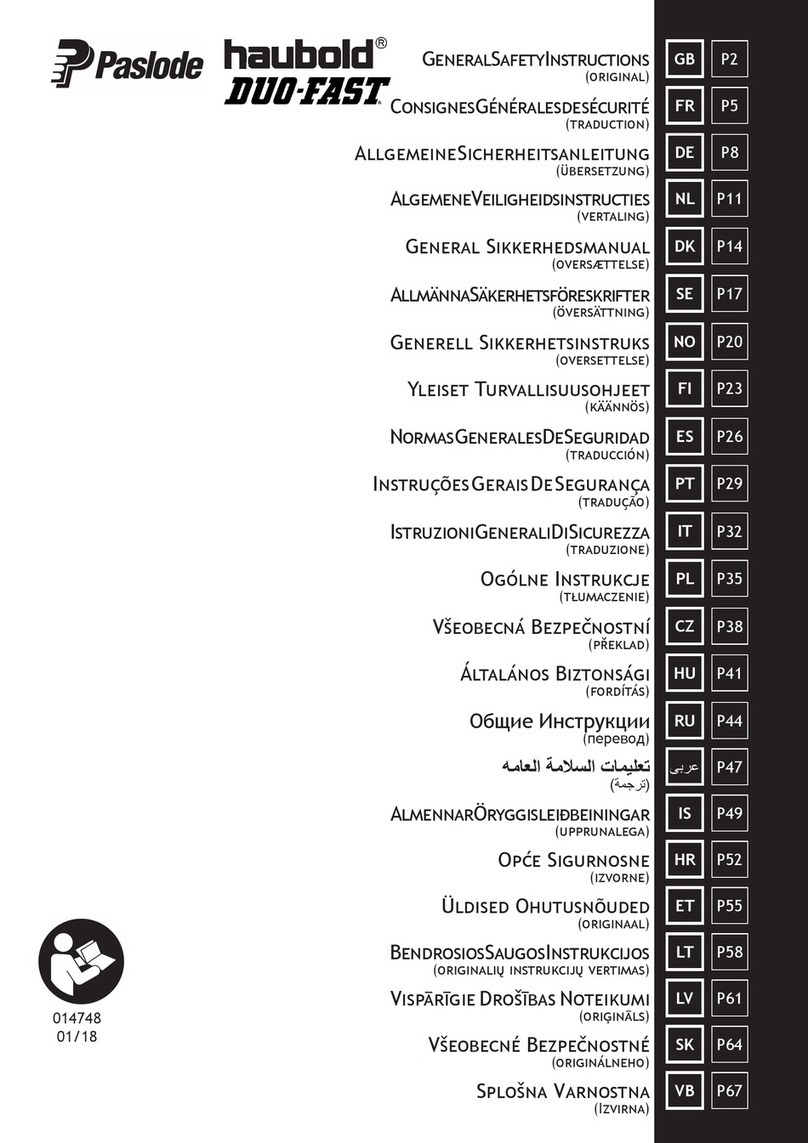
Paslode
Paslode Haubold DUO-FAST Instructions for use
